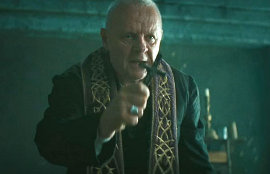 127 HOURS
127 HOURS
At my first screening of Danny Boyle's 127 Hours (which I initially caught in Chicagoland over Thanksgiving weekend), I was immediately knocked out by how vibrantly entertaining it was - hardly a fait accompli when a movie climaxes with a bloody act of self-amputation.
Based on a 2004 memoir by Aron Ralston, the film concerns Ralston's five-day-plus ordeal in Utah's Blue John Canyon, when a rock-climbing accident led to the amateur adventurer's right arm getting wedged between a boulder and a canyon wall. Facing certain death after his many attempts to dislodge himself failed, Ralston finally escaped by cutting off his arm's lower half with a plastic, barely functional multipurpose tool. And Boyle doesn't for an instant blanch in his detailing of this (literally) painstaking process; Ralston's predicament, and its final, bloody few minutes, are about as aurally and visually harrowing as you could imagine. (A family member with whom I saw 127 Hours said he'd kick my ass if I revealed how he watched a goodly portion of the movie peeking through his fingers, and since it's his birthday on February 1, I won't mention his name. You're welcome, bro.)
But this is a Danny Boyle picture we're talking about, so it should come as no surprise that the director is able to make Ralston's struggle as singularly exhilarating as it is horrific. (This is the man who got audiences cheering a swim through excrement in Slumdog Millionaire ... and Trainspotting.) Beginning with the jazzily edited opening-credits sequence, underscored to the propulsive rhythms of Free Blood's "Never Hear Surf Music Again," Boyle's film is vital and alive in ways that feel inexorably linked to Ralston's own character - or at least the character as personified by the spectacularly engaging James Franco. Barreling into his weekend getaway with almost reckless gusto, Franco's Ralston is high on the freedom of the outdoors and his own devil-may-care nature, and that kinetic joy is expressed in Boyle's filmmaking even when 127 Hours' lead is pinned between two rocks. With its numerous flashbacks and hallucinations, the film is an incredibly lively depiction of forced stasis, and in Ralston's mordantly droll video recordings of his plight, there's cheeky dark humor to spare, especially in the sequence of him imagining his experience as a tacky talk-show anecdote, with Ralston playing both host and guest (and a studio audience providing raucous guffaws).
All this I appreciated - loved - on my first viewing of 127 Hours. On my second, though, which took place this past weekend, it was the heartbreaking emotionalism of Boyle's work that really got to me; I'd say I watched more than half the movie on the verge of tears. We know in advance, of course, that Ralston will indeed survive his entrapment, not that his doing so here is any less involving for being preordained. But what became clearer on a second exposure to the film was how precisely Boyle and co-screenwriter Simon Beaufoy - aided immeasurably by their leading actor's soulful portrayal - crafted the piece to explore a young person's gradual acceptance of impending death. Given too much time to reflect on his life and life choices, Franco's Ralston takes stock of his situation, and comes to recognize how his every experience and decision, from childhood on, seems to have led directly to this; Ralston eventually looks upon his fate as a natural consequence of a lifetime of individual actions (or inaction). Yet the film's expansive and hopeful philosophy is that, knowingly or not, we choose the paths we find ourselves on, and if destiny, luck, and perhaps a higher power allow, we can also choose to correct them. (There may be no more moving moment in 2010 films than Ralston, after successfully freeing himself, looking to the heavens and uttering a quiet "Thank you.") Fast, thrilling, and deeply affecting, 127 Hours is a movie about a man who looks death in the face and decides, however grim the cost, to instead fight for life, and it's one of the most truly inspiring inspirational movies I've ever seen.
 THE RITE
THE RITE
A half hour into director Mikael Håfström's The Rite, after performing what is apparently a weekly scheduled exorcism of a pregnant Italian girl, Anthony Hopkins' elder priest turns to Colin O'Donoghue's obviously underwhelmed seminary student and asks, "What did you expect? Spinning heads? Pea soup?" Um ... yes, please. Considering how ludicrously over-the-top most demonic-possession horror flicks are, it seems churlish to bitch about one that deigns to treat the subject of exorcism seriously. But The Rite, which finds O'Donoghue's dour crises of faith occasionally interrupted by visits from the devil, takes itself so seriously that you have almost no choice but to laugh at it, particularly in its final reels. Hopkins is enjoyable, to be sure, but in making their deadly somber religious thriller, didn't The Rite's filmmakers recognize that the actor's liver-and-fava-beans act stopped being scary about two dozen films ago?










